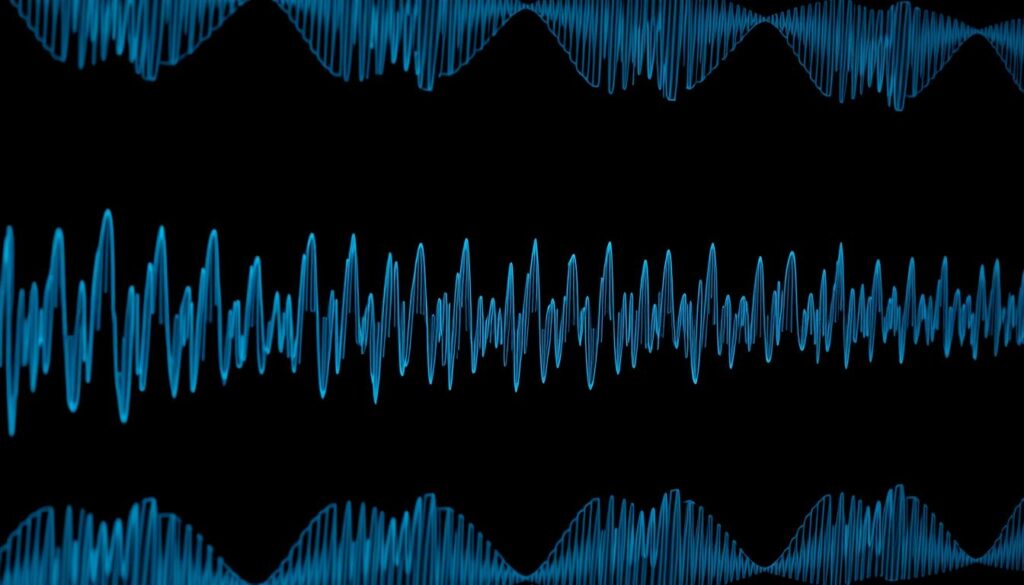The human body’s most restorative sleep phase relies on slow-frequency brain activity that powers essential recovery. These ultra-low oscillations, measured between 0.5 and 4 cycles per second, emerge when the mind enters its most dormant state. Newborns experience this pattern for hours daily, explaining their need for extended rest periods to support rapid growth.
During this phase, the brain prioritizes physical repair and immune system maintenance. Unlike lighter sleep stages, this state minimizes dreaming and external awareness, creating optimal conditions for cellular regeneration. Research shows this biological process helps adults maintain energy levels, cognitive function, and emotional resilience over time.
Understanding these rhythms unlocks opportunities to improve sleep quality naturally. By aligning with the body’s innate recovery mechanisms, individuals can enhance their capacity to heal and recharge overnight. The following sections explore practical strategies to harness this vital aspect of human physiology.
Understanding Delta Waves Hz and Brainwave Frequencies
Brain activity patterns vary significantly across different states of consciousness. Scientists categorize these electrical impulses into distinct groups based on their speed and purpose. Electroencephalogram (EEG) technology tracks these rhythms through sensors placed on the scalp, revealing how mental states shift throughout the day.
What Are the Slowest Brain Oscillations?
The slowest brain rhythms occur during profound rest and recovery. These patterns, often linked to restorative sleep, typically measure below 4 cycles per second. While some research defines their range as 0.1-3.5 cycles, most experts recognize 0.5-4 cycles as the standard classification.
Overview of Brainwave Frequency Bands
Neurological activity forms five primary categories:
- Gamma (30+ cycles): Problem-solving and intense focus
- Beta (13-30 cycles): Active thinking and alertness
- Alpha (8-12 cycles): Relaxed wakefulness
- Theta (4-7 cycles): Light sleep or meditation
- Slowest band (below 4 cycles): Deep physical restoration
These categories help researchers understand how different mental states affect health. Faster frequencies dominate waking hours, while slower patterns emerge during recovery periods. This spectrum explains why quality sleep remains vital for maintaining cognitive sharpness and emotional balance.
The Science Behind Delta Brainwaves

Neural communication relies on synchronized electrical patterns that shift across consciousness levels. These rhythms reveal how the brain transitions between active thinking and restorative downtime. Advanced EEG technology captures these fluctuations, showing how mental states influence physical health.
Brain Electrical Impulses and EEG Insights
Electrodes detect ultra-slow oscillations during deep restoration phases. These signals represent large groups of neurons firing in unison – a sign of minimal conscious processing. Studies show this coordinated activity peaks during dreamless sleep but occasionally appears in advanced meditative practices.
Three key EEG findings explain delta dominance:
- Amplitude increases as mental noise decreases
- Frontal lobe synchronization indicates deep recovery
- Disruptions correlate with chronic fatigue
Comparing Slow and Fast Brainwave States
High-frequency patterns dominate problem-solving tasks, while slow rhythms support biological maintenance. The brainwave frequency spectrum operates like gears in a car:
- Beta (13-30 cycles): Accelerated thinking
- Alpha (8-12 cycles): Idling awareness
- Slowest band: Engine shutdown for repairs
This contrast highlights why alternating between active and restorative states proves essential. The brain prioritizes different functions at varying speeds – like shifting focus from external tasks to internal healing.
How Delta Waves Facilitate Deep, Dreamless Sleep

The deepest phases of nightly recovery occur when brain activity slows to its most primal pattern. This ultra-low frequency state acts like a biological reset button, triggering essential repair processes that lighter sleep can’t achieve.
Phases of Maximum Restoration
During the third and fourth stages of sleep, slow rhythms dominate brain activity. These phases account for 20-25% of adult rest cycles and intensify as night progresses. Three key factors make this period critical:
- Metabolic waste removal accelerates
- Growth hormone production peaks
- Neural networks reorganize
Interruptions during these hours prove particularly damaging. Waking breaks the synchronized neural patterns needed for memory consolidation and toxin clearance. Regular disruptions may lead to foggy thinking and reduced stress resilience.
Next-Day Benefits of Quality Rest
Uninterrupted slow-wave sleep strengthens cognitive function through two mechanisms. First, it reinforces learning by replaying daytime neural patterns. Second, it clears proteins linked to mental decline. People maintaining consistent deep rest often report:
- Sharper focus during complex tasks
- Faster problem-solving abilities
- Improved emotional regulation
This restorative state’s impact extends beyond nightly recovery. By supporting cellular repair and neural maintenance, it lays the foundation for long-term brain health and vitality.
Natural Methods to Enhance Delta Wave Production
Enhancing the brain’s restorative capabilities requires aligning daily habits with its natural rhythms. Simple lifestyle adjustments and mental exercises can optimize conditions for deep recovery, helping the body access its most regenerative states.
Meditation and Mindfulness Practices
Certain meditation styles directly influence brain activity patterns. Transcendental techniques using repeated mantras create rhythmic neural feedback, while mindfulness practices anchor attention to the present moment. Yoga Nidra, a guided relaxation method, combines breath awareness with body scanning to trigger slower brain frequencies.
Studies show these approaches increase delta activity by 20-30% in regular practitioners. Consistency matters – even 15-minute daily sessions yield measurable changes over weeks.
Sleep Hygiene and Relaxation Techniques
Quality sleep remains the foundation for delta wave production. Three key environmental factors enhance this process:
- Cool bedroom temperatures (60-67°F)
- Complete darkness using blackout curtains
- White noise machines to mask disruptions
Evening relaxation rituals like progressive muscle relaxation or nature sound playlists prepare the mind for deeper rest. Pair these with consistent bedtimes to reinforce the body’s internal clock, maximizing time in restorative sleep phases.
Delta Waves in Restorative Processes and Healing

Nightly restoration reaches its peak when the nervous system shifts into its most regenerative mode. This phase activates biological processes that repair cellular damage and strengthen defenses against illness. Deep sleep becomes the body’s maintenance workshop, working silently to rebuild what daily life wears down.
Tissue Regeneration and Growth Hormone Release
During slow-wave activity, the body floods the bloodstream with youth-preserving compounds. Human growth hormone surges by up to 75%, driving muscle repair and bone density improvements. Anti-aging agents like melatonin and DHEA simultaneously neutralize free radicals while enhancing cellular renewal.
Three critical restoration events occur:
- Damaged cells receive resources for rapid rebuilding
- Skin and organ tissues accelerate regeneration
- Pain signals diminish through natural anti-inflammatory effects
Immune Function and Stress Reduction
The immune system undergoes crucial upgrades during these restorative phases. Cytokine production increases, creating specialized proteins that target infections. This biological reinforcement helps the body mount faster responses to pathogens while reducing chronic inflammation risks.
Stress hormone levels plummet as cortisol production slows. This dual-action benefit:
- Protects against anxiety-related disorders
- Preserves cognitive function over time
- Strengthens emotional resilience
Regular deep sleep patterns create compounding health advantages. By supporting both physical healing and mental recovery, these rhythms form the foundation of overall health maintenance.
Delta Waves and Brain Function: Memory, Stress, and Healing

The brain’s capacity to manage daily challenges depends on nightly neural maintenance. Slow oscillations during deep rest coordinate essential repairs that sharpen mental clarity and emotional stability.
Memory Optimization Mechanisms
Delta brainwaves strengthen memory retention by reactivating neural pathways formed during wakefulness. This nocturnal replay system filters important experiences into long-term storage while discarding irrelevant data. Studies demonstrate a 40% improvement in recall accuracy following uninterrupted slow-wave sleep.
Key cognitive enhancements include:
- Quicker information processing speeds
- Heightened situational awareness
- Improved multitasking capabilities
These benefits arise from increased connectivity between the hippocampus and cortex – regions critical for learning integration.
Simultaneously, delta patterns help reduce stress levels by suppressing cortisol production. Lower stress hormones enable the body to prioritize cellular repair and tissue regeneration. This biological trade-off explains why well-rested individuals often exhibit:
- Stronger immune responses
- Faster physical recovery times
- Greater emotional equilibrium
Disrupted neural rhythms create vulnerabilities in both cognitive function and healing processes. Maintaining consistent sleep quality serves as foundational protection against mental fatigue and chronic health conditions.
The Role of Delta Waves in Neurofeedback and Meditation
Cutting-edge technologies and ancient mental training methods now harness the brain’s restorative states for improved well-being. Neurofeedback systems use real-time monitoring to help users influence their neural activity. By observing brain patterns through EEG sensors, individuals learn to prolong periods linked to physical recovery and mental clarity.
Meditation practices naturally cultivate similar effects through focused attention. Techniques like rhythmic breathing and body scans create conditions for slower brain activity without technological aids. Research shows both approaches enhance sleep quality and cognitive function by reinforcing neural pathways associated with deep restoration.
These methods work through shared biological mechanisms. Regular sessions strengthen the brain’s ability to transition between active thinking and recovery modes. Over time, users often report better stress management and heightened awareness during waking hours – evidence of lasting neurological adaptation.
The synergy between modern science and traditional practices offers new paths to wellness. By consciously shaping brain activity, individuals gain practical tools to support their body’s natural healing processes.





